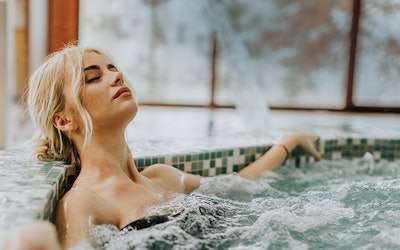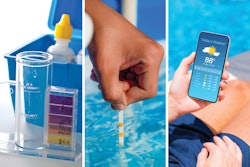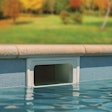
Despite some long-held beliefs, a spa is simply not a small pool. There are major differences between the chemistry of hot water environments and pool water environments – differences unique enough to warrant a separate discussion. For service technicians, understanding these differences and knowing how to alter your pool testing and treatment regimen to one suited for spas is critical for maintaining healthy water for their customers.
So, how does spa water differ from pool water?
Although pools and spas are both filled with water and require regular testing and treatment, that’s where the similarities end. Higher temperatures, smaller volume, jetted water and the likelihood of high/dense bather loads must all be taken into account when formulating a water treatment strategy. Of that list, the two most significant differences are higher temperatures and smaller volumes.
HIGHER TEMPERATURES
The temperature currently recommended by the industry for pool water is 78–82 degrees Fahrenheit (25.5–27.8 degrees Celsius). For spas, the recommendation is a temperature no higher than 104 degrees Fahrenheit (40 degrees Celsius). Higher temperatures can lead to major health issues, such as hyperthermia.
Higher temperatures also have a tendency to increase bacterial growth, such as Pseudomonas aeruginosa, the most common bacteria found in hot water environments. In warmer water, our skin pores open up, allowing these bacteria to enter our bodies. As a result, mild skin rashes (sometimes referred to as “hot tub rash”) and ear infections can occur when the sanitizer is not maintained at the proper level.
RELATED: Water Testing Made Easier
Keep in mind that for every 18-degree Fahrenheit (or 10 degrees Celsius) increase in water temperature, chemical reactions will increase twofold. That explains why sanitizers are said to be short-lived in spa water due to the accelerated depletion rate.
Higher temperatures also come with a greater tendency for calcium hardness to come out of solution, resulting in crusty deposits on surfaces and equipment, clogged fi lters, reduced circulation and cloudy water. For those reasons, the recommended calcium hardness level for spas is only 150–250 ppm, whereas the recommended level for pools is 200–400 ppm.
Approximately 50% of water loss in pools and spas is due to evaporation, and the jetted water in spas increases that rate. As a result, the decreased water volume generates an increase in the accumulation of total dissolved solids. Although a minor component of overall water balance, TDS can present a problem if allowed to build up; it can slow down chemical reactions, contribute to the corrosion of pool components and create dull, uninviting water.
In addition, natural body oils, perspiration, etc., are expelled at a faster rate in warm water than in the cooler temperatures found in pool water. Heated water encourages more urine/sweat production — an average of 50 mL urine and 200 mL sweat during an average 15–20 minute soak. Therefore, the importance of maintaining proper sanitizer levels cannot be emphasized enough.'
SMALLER VOLUMES
“Teaspoon chemistry” is a term some spa service technicians use to describe how spas should be chemically treated. Smaller volumes of water need only a fraction of the chemical dosage required for a pool — teaspoons of this or capfuls of that as opposed to pounds or gallons! Many spa owners think more is always better, so they add more treatment products than necessary, which just creates more problems.
Spa volumes vary from as low as 150 gallons (for residential spas) to as high as 2,500 to 3,000 gallons or more (for commercial spas). No matter the volume, the turnover rate (the amount of time required to cycle all of the water through the filter once) is anywhere from 15 to 45 minutes for spas compared to 6 to 8 hours for pools.
RELATED: Healthy Hot Water
The spa’s smaller volume of water means the ratio of bathers to water volume is higher, and thus the sanitizer can be quickly depleted. Four people in a 400-gallon spa is roughly equivalent to 250 people in a 25,000 gallon pool. Four people in a 400-gallon spa will consume 2 ppm free chlorine in the first 15 minutes.
WATER BALANCE IN SPAS
The five parameters of water balance are pH, total alkalinity, calcium hardness, temperature and total dissolved solids. These five factors are then used in the Langelier Saturation Index to obtain a number that represents whether the water in a spa has a tendency to be corrosive or scale-forming.
Langelier Saturation Index:
SI = pH + TF + logCH + logALK - CONSTANT
SI = Saturation Index
pH = measured pH
TF = temperature factor
CH = measured calcium hardness
ALK = measured carbonate alkalinity
CONSTANT = combined factor for temperature and ionic strength correction, and concentration conversions
Ideal Ranges Recommended for Spas:
Free Chlorine 3.0–5.0 ppm
Combined Chlorine 0 ppm
Bromine 4.0–6.0 ppm
pH 7.4–7.6
Total Alkalinity 80–120 ppm
Calcium Hardness 150–250 ppm
Maximum Temperature 104ºF (40ºC)
Total Dissolved Solids No greater than 1500 ppm above source water TDS level
Spa water is considered “balanced” if the result of the SI calculation falls between -0.3 and +0.5. Positive values greater than +0.5 can indicate the potential for cloudy/scaling water. Negative values less than -0.3 can indicate the potential for corrosive water.
RELATED: 5 Ways to Make Your Water Testing Station Pop
If spa water (or pool water) has an SI lower than -0.3, it will naturally attempt to balance itself by seeking calcium carbonate (CaCO3) from any source in its quest (concrete, plaster, and especially grout or gunite), leaving behind pits, holes and other signs of deterioration. Although this is not as much an issue since most spas have fiberglass/acrylic shells, the water will still behave aggressively and attack any metals in the system, like heater tubes, causing corrosion and eventual failure of the metals.
It should be noted that aeration (jetted water) causes pH to rise by introducing additional hydroxide ions (OH-) into the water. Careful and consistent pH testing is needed to make sure that the increased pH level does not affect water balance or cause cloudiness/scaling.
THE ULTIMATE SOLUTION
Despite well-meaning attempts to properly sanitize, oxidize, balance and filter hot water, at some point (because of the combination of smaller volumes and larger bather loads) you will need to drain and refill a spa with fresh water.
In the 1990s, a formula was developed to determine how often spas should be drained and refilled with fresh water. This formula is a guideline for draining both residential spas and commercial/public spas. The first step is to take one-third of the total gallons of water in the spa and divide that by the maximum number of daily bathers (“bather” equals one 20-minute soak) to give you the number of days between complete draining/refilling:
# of days = 1/3 volume (gallons)
maximum # daily bathers
Scenario #1
Your residential customer has a 600-gallon spa.
- 600 ÷ 3 = 200
- Every day, two people use this spa (200 ÷ 2 = 100).
- Therefore, the spa should be drained and refilled every 100 days.
Scenario #2
Your commercial customer (health club) has a 1,500-gallon spa.
- 1,500 ÷ 3 = 500
- Every day, 100 patrons use this spa (500 ÷ 100 = 5).
- Therefore, the spa should be drained and refilled every 5 days.
SPA WATER SANITATION/OXIDATION
When selecting which sanitizing/oxidizing method to use for a hot water environment, there are a few basics you must understand if you want to get the best bang for your buck.
- Hot water environments deplete chlorine (stabilized or unstabilized) faster than bromine.
- Chemical reactions occur faster in hot water environments than cooler water environments.
- Treatment chemicals are added in significantly smaller amounts in spas than in pools.
- The ultimate solution to ANY pool/spa chemistry problem is FRESH WATER!
- Organic loads are more concentrated in smaller volume spas; each bather contributes anywhere from 10 to 100 million bacteria to the water!
Okay, now that the basics are out of the way, let’s talk about the most popular options available for sanitizing/ oxidizing spas.
CHLORINE
Clearly the preferred sanitizer/oxidizer product in the pool/ spa industry, chlorine is readily available in a variety of forms (powder, granules, liquid, tablets, pucks, etc.). The primary question to ask before using chlorine is whether the spa is indoors or outdoors. If indoors, then chlorine is not always the best choice since it can create a multitude of problems if the spa is not properly maintained. The poor air circulation combined with a buildup of combined chlorine can irritate the eyes and mucous membranes and also create that smelly “chlorine odor” often associated with indoor spas.
RELATED: The Right Way to Approach Hot Water Care
If your spa is located outside and you prefer to use chlorine, remember to use a “stabilized” form (dichlor or trichlor), which will slow down the decomposition of the chlorine due to sunlight. Dichlor is almost pH neutral at 6.6. Trichlor, however, carries an acidic pH (2.8–3.5). The unstabilized forms of chlorine (calcium, lithium and sodium) all have higher pH levels ranging from 8.5 to 13. Understanding the pH levels of products will help you better control the water’s pH levels.
BROMINE
There are four key advantages of using bromine rather than chlorine in spa environments:
1. Bromine is more effective over a wider pH range, whereas chlorine’s effectiveness decreases as pH rises.
2. Bromamines are almost as effective at sanitizing/oxidizing as free bromine.
3. Bromamines, formed in reaction with ammonia wastes, do not have the unpleasant odor of chloramines and are less irritating to the eyes and respiratory tract.
4. Bromine lasts longer in hot water environments than unstabilized chlorine.
Generally, bromine can be purchased in tablet form: BCDMH (1-bromo-3-chloro-5,5-dimethylhydantoin) or DBDMH (1,3-dibromo-5,5-dimethylhydantoin). Tablets are placed in an erosion feeder (or floater), and as spa water spills over the tablets, bromine is introduced into the water. Bromine is unique in that it needs a “kick start” to get it going (think of starting a motorcycle or dirt bike). That kick start is any oxidizing substance (chlorine, ozone, monopersulfate). This in turn starts what is called the “bromine cycle.”
If you use BCDMH tablets, there is no need to add a separate oxidizer — it’s already there (the “C” in BCDMH stands for chlorine). If using DBDMH, you’ll need to add an oxidizer separately.
The one “gotcha” with using bromine is that it is slightly acidic. BCDMH has a pH of 4.5–4.8 and DMDBH has a pH of 6.6. These lower pH levels can be corrected with proper water balance practices – specifically, making sure the total alkalinity level is sufficiently high (but still within acceptable ranges) to offset the lower pH. Spa equipment can be damaged if exposed to low pH levels.
RELATED: Bromine Chemistry for Spas and Pools
Another important factor to consider is that bromine has no commercially available stabilizer; therefore, bromine is best used for indoor spas and for covered spas outdoors.
OZONE
Ozone is another option for sanitizing spas. Gaining in popularity, many spa manufacturers now include ozonators in newer spa structures. Ozone is an excellent oxidizer, but its usefulness as a sanitizer is limited as it readily converts to oxygen as soon as it hits the water’s surface. If using ozone, manufacturers recommend using a very small amount of chlorine or bromine to create a sanitizing residual in the water — usually half of what would be used if no ozone were present.
OTHER SANITIZING/OXIDIZING METHODS
Ionization is a method that generates copper and silver ions to provide algaecidal properties and extremely limited biocidal properties. It’s important to remember that ionizers (aka mineralizers) are not oxidizer/ sanitizer systems. Despite marketing claims, ionizers require a small amount of chlorine to provide a sanitizing/oxidizing residual in spa water. Caveat: Do not use bromine with ionizers as silver bromide may form. This chemical compound is potentially hazardous if ingested and can stain acrylic/fiberglass shells.
Polyhexamethylene biguanide (PHMB) products are used primarily for microbiological control. Because PHMB lacks oxidation capabilities, hydrogen peroxide needs to be added as an oxidizer/shock to eliminate any organic buildup. It is important to note that PHMB is not compatible with most halogen-based products (chlorine, bromine, ozone), monopersulfate and copper-based algaecides.
Potassium monopersulfate (KHSO5) is an oxygen-based oxidizer (not a sanitizer) used to remove organic buildup, prevent new combined chlorine formation, and kick start the bromine cycle. This product dissolves quickly, produces no odors or irritation and bathers can get back in the spa within 45 minutes to an hour after it is added. Caution should be used with monopersulfate as it has an extremely low pH (2.3), and overdosing can lead to equipment corrosion and/or water balance problems.
Now that you know the basics of hot water chemistry, you have the tools necessary to ensure the water in your customers’ spas is healthy (healthy water = happy customers). Remember, happy customers are your best source of advertisement!











































